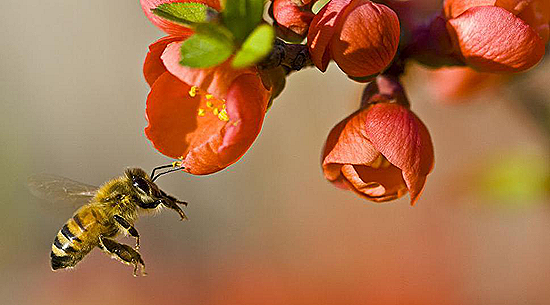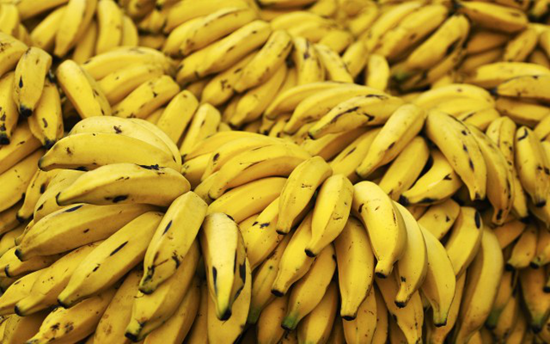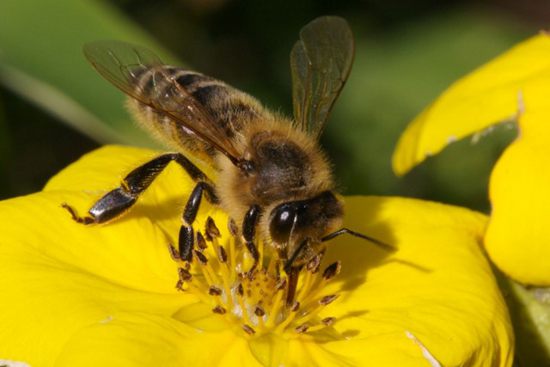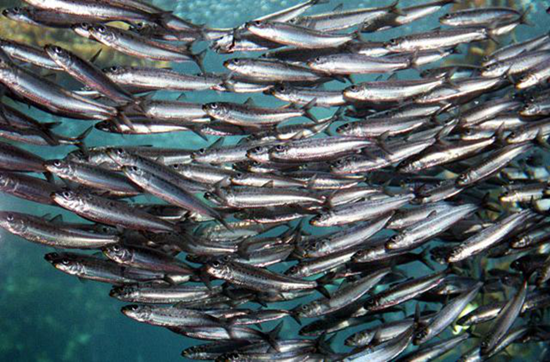
Like it or not, resources are finite. If we don’t use them carefully, we’ll run out. But while we’ve all heard the scary stories about peak oil, we’re guessing you had no idea that we’re running the risk of hitting peak banana.
10. Bananas
Latin America is the largest cultivator of bananas in the world, with around 70% of all production. That makes for a US$8.9 billion a year industry. Humans have been growing bananas for at least 10,000 years, and they’re an important part of the everyday diet for countless people. They’re rich in magnesium, potassium and vitamins C and B6, making them the most consumed fruit in many countries.
The bananas we’re accustomed to, the Cavendish species, is the only type grown on a large scale. It’s a monoculture, meaning that every banana tree is one and the same and all bananas in every supermarket are basically clones of each other. Recently, a banana fungus known as Tropical Race 4 is attacking banana trees, inhibiting their ability to extract nutrients from the soil. This fungus can’t be killed by any current fungicides and can easily move from place to place by sticking to boots, clothing, tools and even water. It has spread to Asia, Africa and the Middle East, and appears to have hit Latin America as well.
The only way to stop this plight is to quarantine and destroy the infected plants. Otherwise the Cavendish will be all but wiped out, forcing us to replace it with one of the other 1200 banana species out there. These other breeds look and taste different, but maybe that’s something we’ll have to adjust to.
9. New Music
The Gracenote database holds 130 million songs from around the world. If we were to listen to them all day and night, it would take us 1200 years. That’s not even close to what all the possible combinations of tones put together can add up to, and we can safely say that new music will be created as long as humans exist.
But humans have a relatively small capacity to hear sounds - our range is between 20 and 20,000 Hz. Together with the fact that we have a preference for only particular notes and have a tendency to borrow and remix songs and tones from the past, the number we’re talking about drops significantly. The exact date when all possible combinations of sounds capable of forming new and enjoyable music will be reached is unknown and likely far in the future, but we have to keep in mind that someday it will come to an end.
8. Wine
As temperatures keep rising, predictions show that large areas where grapes are currently grown will be unsuitable by 2050. Vineyards need cold winters and hot, dry summers, and places like Bordeaux, Rhone, Tuscany, Chile, Argentina, Southeast Europe and Napa Valley will no longer be able to do so. Even the vineyards in Southern Africa and Australia will suffer tremendously, with simulations showing a 70-75% drop in production over the next several decades. We’ve already see the effects of climate change on wine production, with a 4% drop in 2014.
These famous wine countries won’t be completely unable to produce, but tremendous expenses in irrigation and other special adjustments will need to be made in order for to continue production. Fortunately, other areas will become perfect for wine production, such as Germany, the Netherlands or even England and Yellowstone Park. Central China and Tasmania could also do well in the near future. But most of these areas are either cultivated with something else or are wild. Moving the wine industry would be extremely costly, and could threaten animals like the panda with extinction.
7. Helium
Helium is the second most abundant element in the universe. It’s also among the lightest. That means the helium that’s here on our planet escapes the atmosphere on a regular basis.
Besides being a source of fun at kid’s parties, helium is also used for welding, as a super coolant for MRI machines, in the Large Hadron Collider, in diving and in growing silicon crystals, among other important uses. The reason we don’t notice the scarcity of the gas is because the United States National Helium Reserve, which houses around one billion cubic meters of the stuff, was mandated back in 1966 to sell all helium at extremely low prices until 2015.
Now that the reserve is almost up, we’ll most likely see a steep rise in helium prices because now we have to make our own. To do so, we need to tap into natural gas production, since 7% of it is helium. Qatar finished building a facility in 2013, which is capable of producing 60 million cubic meters, making it the second largest producer after the US.
6. Honey Bees
Bees have been around for some 74 to 146 million years, before the continents even drifted apart. Their appearance seems to coincide with the evolution of the first flowering plants. Currently there are several species, but the most common and most useful to us is the European Honeybee. This species was domesticated as early as 1000 BC in Egypt, and has since been transported to every continent for their delicious honey and useful wax.
Today these little insects are under threat by a phenomenon known as Colony Collapse Disorder (CCD), which has wiped out 36% of hives in the US alone. The causes behind this plight are varied and not completely understood. Scientists believe that mites, infectious agents, weather patterns, electromagnetic radiation, pesticides, poor nutrition and stress are the main factors, as well as the Israeli acute paralysis virus. CCD was first documented in 2006, and no viable solution has been found yet. And even if you think you could live without honey and wax, bees pollinate over one third of the world’s food supply. Without them, plants can’t grow and reproduce.
5. Medical Isotopes
Utilized in detecting bone cancer and brain and kidney diseases, medical isotopes are used by over 70,000 people every day. They make use of a radioactive tracer called technetium-99m which is made inside research nuclear reactors. Back in 2009, two of these reactors shut down for repairs since they’re over half a century old.
This flung the medical community into a panic, and many professionals had to resort to older and less reliant techniques for treatment which involve exposing patients to high doses of radiation. There was no stored supply of the isotope, because it only has a 12 hour lifespan. Nevertheless, it’s used in over 80% of all medical imaging worldwide.
What’s even more disturbing is that the Canadian Chalk River reactor, which produces more than a third of the world’s Tc-99, will permanently shut down in 2016, leaving a gap in the isotope supply chain that no one can fill anytime soon. Some North American companies are looking into the problem and seem to have come up with a way of producing Tc-99 without the need of nuclear reactors. But the miles of red tape they have to get past, together with the fact that it will take them years before any viable production will begin, will leave countless people without a reliable diagnosis.
4. Caviar
We all know that caviar is a luxury food - a spoonful can cost as much as a full meal. Caviar is made from the eggs of the beluga sturgeon, native to the Caspian and the Black Sea. It can live for more than 100 years, and can weigh up to two metric tons. They’ve been around since the time of the dinosaurs, but recently it’s been classified as critically endangered because of overfishing and loss of habitat.
The United States imports over 80% of the world’s caviar, which is worth around US$100 million per year, but the black market is believed to be 10 times larger. An import ban has been put in place in both the US and EU to conserve and regenerate the population of sturgeons. This has led to prices skyrocketing from US$2000 per kilogram to a whopping US$10,000. This steep rise has made the black market explode, and not even a 10 year suspension of activities from countries producing caviar - Kazakhstan, Azerbaijan, Turkmenistan, Iran and Russia - has been able to properly stop it.
3. Sardines
While we’re on the subject of dwindling marine life, here’s another fish that will soon disappear from supermarket shelves. This is due to overfishing and the cooling of the North Pacific waters since the 1990s. Sardines love slightly warmer waters, and a sudden shift in temperature can have dire consequences on the marine ecosystem.
This phenomenon wasn’t a surprise, as scientists has been warning it could happen. Nevertheless, heavy fishing continued, and in 2013 fishing nets of the Pacific coast of Canada came up empty. This happened before in the 1940s when the waters cooled and the sardine population dropped, but now that there are more fishing boats their population will take even longer to replenish, if they ever do.
What’s even more troublesome is that because of size-selective fishing, the average size of many fish species has dropped to about half of what they used to be in the 1970s. Laws and regulations were put in place to preserve younger fish, while the bigger ones were up for grabs. Since only smaller fish were left in the oceans, their offspring were also smaller. That’s one well-intended law that backfired.
2. Antibiotics
Antibiotics aren’t disappearing, but they are becoming obsolete. Like every living thing on Earth, bacteria are constantly evolving to better cope with outside forces. That’s why over 23,000 people die each year in the US alone from antibiotic-resistant microorganisms.
This is a natural event, but one that was greatly accelerated by the overuse of antibiotics for simple cases sore throats and virus related illnesses which can’t be cured with antibiotics. We also take on antibiotics when we eat most kinds of meat.
To make matters worse, pharmaceutical companies have found that investing in antibiotic related development is no longer worthwhile financially, and are diverting investments into chronic illness drugs that can be used over the long term. The situation looks so overwhelming that some have proposed the money come from the military budget, since this situation may soon become a matter of national defense.
1. Sand
Coming back home from the beach with sand all over your swimwear could soon be a thing of the past, since there will be no more beaches to go to. Because of rising sea levels and increased storm activity, not to mention massive erosion caused by human shore line development, somewhere between 70 to 90 percent of the world’s beaches are disappearing.
This phenomenon isn’t visible to those of us living inland who only visit the seaside in the summer, but people closer to beaches can attest that sand is brought in by the truckload every season to fill in the gaps. You might think that using desert sand would be a great solution since it just sits there doing nothing, but that type of sand is much finer that beach sand and will simply be blown away by the wind. That’s why Dubai replenishes its beaches every year with sand shipped all the way from Australia.
In Africa and Asia, beaches are stripped bare by people collecting sand for construction sites. People go to the seaside not to sunbathe and swim, but to gather what sand is left, sometimes risking their lives for a few buckets of sand while the tides pull at their feet and waves crash overhead. So maybe next summer just take the family to the local pool instead.










No comments:
Post a Comment
Please adhere to proper blog etiquette when posting your comments. This blog owner will exercise his absolution discretion in allowing or rejecting any comments that are deemed seditious, defamatory, libelous, racist, vulgar, insulting, and other remarks that exhibit similar characteristics. If you insist on using anonymous comments, please write your name or other IDs at the end of your message.